The AMD Radeon R9 380X Review, Feat. ASUS STRIX
by Ryan Smith on November 23, 2015 8:30 AM EST- Posted in
- GPUs
- AMD
- Radeon
- Asus
- Radeon 300
Meet the ASUS STRIX R9 380X OC
For the launch of the Radeon R9 380X AMD sampled us with ASUS’s STRIX R9 380X OC. Arguably the highest-end of the R9 380X launch cards, the STRIX R9 380X OC comes with a factory overclock tied for the largest of any R9 380X and a further optional overclock for $259.
| Radeon R9 380X Cards | ||||
| ASUS STRIX R9 380X OC | Reference R9 380X | |||
| Boost Clock | 1030MHz / 1050MHz (GPUTweak OC) |
970MHz | ||
| Memory Clock | 5.7Gbps GDDR5 | 5.7Gbps GDDR5 | ||
| VRAM | 4GB | 4GB | ||
| Length | 10.75" | N/A | ||
| Width | Double Slot | N/A | ||
| Cooler Type | Open Air | N/A | ||
| Price | $259 | $229 | ||
The STRIX R9 380X is the latest entry in ASUS’s popular STRIX family of cards. At one point STRIX was ASUS’s brand for upscale video cards, occupying a slot between their standard cards and their high-end Republic of Gamers cards, but at this point with the majority of ASUS’s cards falling under the STRIX branding, it arguably has transformed into what is their de facto mainstream lineup of video cards.
The STRIX R9 380X OC ships at 1030MHz for the core clock, a 60MHz (6%) boost over the reference R9 380X. On top of that ASUS offers a pre-programmed 1050MHz mode via their GPU Tweak software, though a further 20MHz overclock is going to be pretty small in the long-run. Otherwise ASUS only touches the GPU clockspeed, leaving the memory clock at AMD’s default of 5.7Gbps. Out of the box, the STRIX R9 380X OC is going to be around 4% faster than a reference R9 380X card.
Like the other STRIX cards we’ve looked at this year, ASUS has been focusing on workmanship and a common visual theme for these cards. The STRIX R9 380X OC features a version of one of ASUS’s DirectCU II coolers, combining an oversized fan assembly with a 3 heatpipe heatsink assembly. The fan assembly in turn uses a pair of the company’s “wing-blade” fans, each measuring 94mm in diameter and giving the fan assembly its overall large size.
As is usually the case on ASUS cards, the STRIX R9 380X OC implements ASUS’s variation of zero fan speed idle technology, which the company calls 0dB Fan technology. While ASUS is no longer the only partner shipping zero fan speed idle cards, they are still one of the most consistent users of the technology, and surprisingly we still don’t see this in every open air card released on the market.
Sitting below the fan assembly, the DirectCU heatsink being used in ASUS’s 380X card is a typical tri-pipe configuration. The aluminum heatsink runs virtually the entire length of the card – and past the PCB – with a pair of 8mm heatpipes and a 10mm heatpipe providing additional heat transfer between the Tonga GPU and the rest of the heatsink. ASUS’s design doesn’t make contact with anything other than the GPU – so the GDDR5 RAM chips sit uncovered – with the airflow coming through the heatsink being sufficient to cool those chips.
Moving on to the PCB, ASUS has implemented their standard Super Alloy family of MOSFETs, capacitors, and chokes. ASUS uses an 8 phase VRM system here, taking advantage of the already oversized fan assembly to allow them to use a slightly taller than normal PCB to fit all of the power phases.
Flipping over to the back side of the card, we find a full-size backplate running the length of the card. There are no critical components on the back of the card, so while the backplate doesn’t provide any cooling it does serve to protect the card and reinforce it against bending. To that end a small lip extends past the backplate and meets up with the heatsink, preventing the heatsink from flexing towards the board. Small details such as these are why the STRIX cards have consistently been the most solid of the custom cards to make it through our hands this year, as the card is well-supported and isn't free to warp or bend.
Looking at the back we can also see the two 6-pin power connectors used to supply additional power to the card, along with the red and white power LEDs for each connector. Like some of their other cards, ASUS has flipped the PCIe power connectors so that the clip is on the back side of the card, keeping the clip clear of the heatsink and making it easier to plug and unplug the card. On a side note, I suspect this will be one of the last cards we review with two 6-pin connectors rather than a single 8-pin connector. Though electrically equivalent (150W), we’re already seeing cards like the R9 Nano shipping with the single 8-pin connector, and dual 6-pin connector cards will become increasingly rare.
As for Display I/O, ASUS is using a rather typical 1x DL-DVI-I, 1x DL-DVI-D, 1x DisplayPort, 1x HDMI port configuration. Multiple DVI ports, though not in any way petite, have been a common fixture on sub-$250 cards this generation and will likely remain that way for some time to come due to slower adoption of newer display I/O standards in the APAC market, which only recently has finally seen analog VGA phased out.
Finally, on the software front, the STRIX R9 380X OC includes ASUS’s GPU Tweak II software. The software hasn’t significantly changed since we last looked at it in July, offering the basic overclocking and monitoring functions one would expect from a good overclocking software package. GPU Tweak II allows control over clockspeeds, fan speeds, and power targets, while also monitoring all of these features and more.
Wrapping things up, as briefly mentioned earlier the STRIX R9 380X OC is the most expensive of the R9 380X launch cards. ASUS is charging a $30 premium for the card over AMD’s reference MSRP, putting the price at $259. Premium, factory overclocked cards aren’t anything new, but it does mean ASUS is in a bit of a precarious spot since the much more powerful Radeon R9 390 cards start at $289, meaning the premium price further amplifies the spoiler effect of the R9 390.


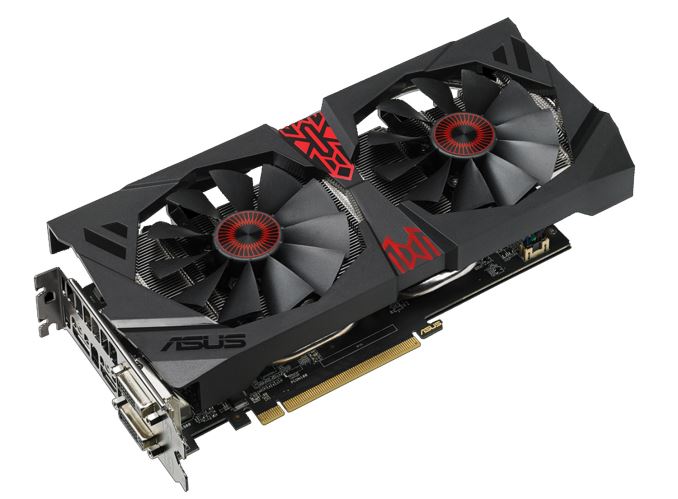
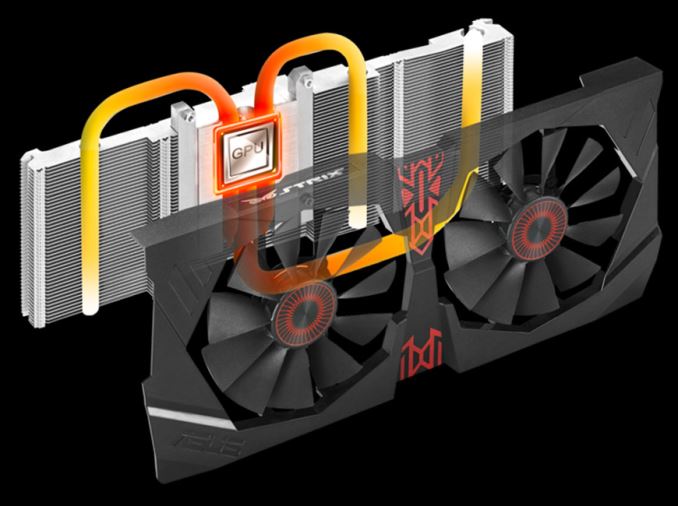
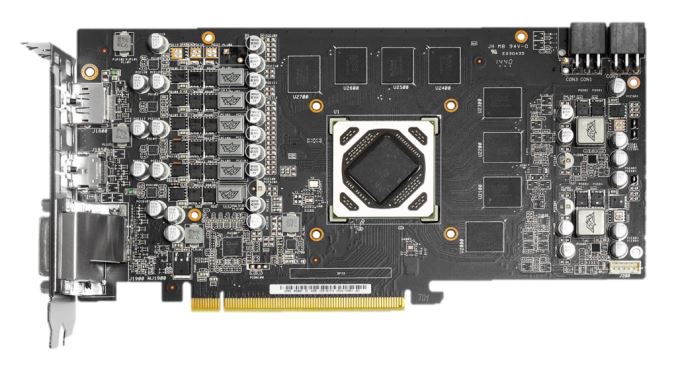
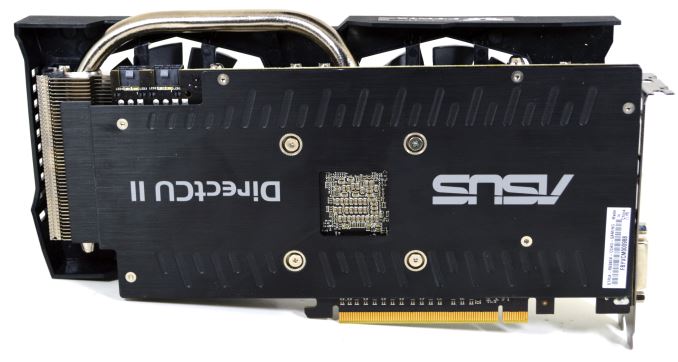

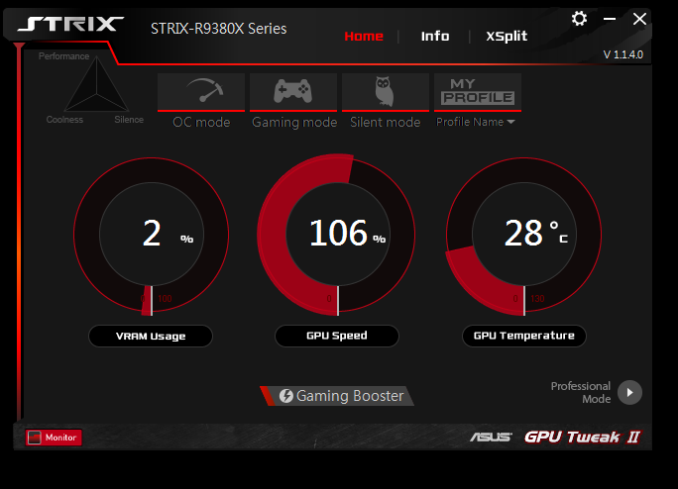








101 Comments
View All Comments
godrilla - Monday, November 23, 2015 - link
Newegg has the PowerColor r9 390 for $265.99 preblackfriday deal, for a bit more you get 20% more performance and double the vram!r3loaded - Tuesday, November 24, 2015 - link
Good to see my 7970 is still holding up very well even after almost four years!Enterprise24 - Tuesday, November 24, 2015 - link
7970 from 2011 can still compete with 380X in 2015.CiccioB - Tuesday, November 24, 2015 - link
Even the GTX480 can compete with GTX750Ti... something to be proud of, isn't it?evilspoons - Tuesday, November 24, 2015 - link
Ah, I'm still undecided what to do with respect to replacing my SLI GTX 680s. I'm in Canada so we're getting murdered by the exchange rate (GTX 970 is $380-$450, R9 390 is $450, the first R9 380X cards are $330...).Guess I'll just hold on to my 680s a while longer.
Mugur - Wednesday, November 25, 2015 - link
I don't think that 380x is a bad card, by any means. It just needs to replace 380 4GB in that price slot and/or the OEMs to bin 380 with only 2 GB of RAM and let the 4G only for 380x. Currently, although understandable for the "novelty" factor, I saw in my country the Asus 380x Strix OC with the same price that some (discounted or not) GTX 970 or R9 390 cards (including an Asus Strix 970 OC :-) ) which is hilarious. Also with like 50% more than a Sapphire Nitro 380 4GB that I bought on Black Friday. Or AMD could simply replace 380 with 380x if the yields are good enough...SolMiester - Wednesday, November 25, 2015 - link
LOL, bit late to the party isnt it, anyone buying mid range has probably already purchased this generation...aria - Monday, November 30, 2015 - link
I'm not sure I agree. I'm still rocking an HD 7750 (perhaps "wheeling," as in "wheelchair" might be more appropriate at this point). It was mid-tier when I got it, but now it's not really sufficient. I'd like to play games at 1920x1080, but i don't really care; 1360x768 is good enough for me. But my current card can't even deliver that at 60 fps any longer (I actually think the card has deteriorated, because I played Dragon Age Inquisition last year on decent settings, and now I can't run it at 15 fps on Low and 1024x768). Anyway, most people using mid-tier I imagine are more like me. We don't purchase an upgrade as soon as one is available--we want to get the highest mid-tier we can, which involves waiting. If I'd replaced my 7750 two months ago, today I would have an inferior mid-tier card, which certainly will become important a year from now when I'm trying to get just a bit more performance out of it. 10% doesn't matter today, but 18 months from now that 10% will mean the difference between playable and unplayable. The rules of high end gaming aren't applicable at the mid-tier range, because we don't buy an upgrade simply because it's an upgrade.HollyDOL - Thursday, November 26, 2015 - link
Another proof graphics industry badly needs new manufacturing process. Possibilities of what can be achieved at 28nm (GPU wise) seem to be exhausted. It will get interesting with new process + HBM2, until then it's going to be a stall water.lazymangaka - Tuesday, December 1, 2015 - link
Unless someone was able to snag the 380X at a significant discount, I would have trouble justifying not spending the extra money to jump to the 390. That really looks like it would be $60 well spent.